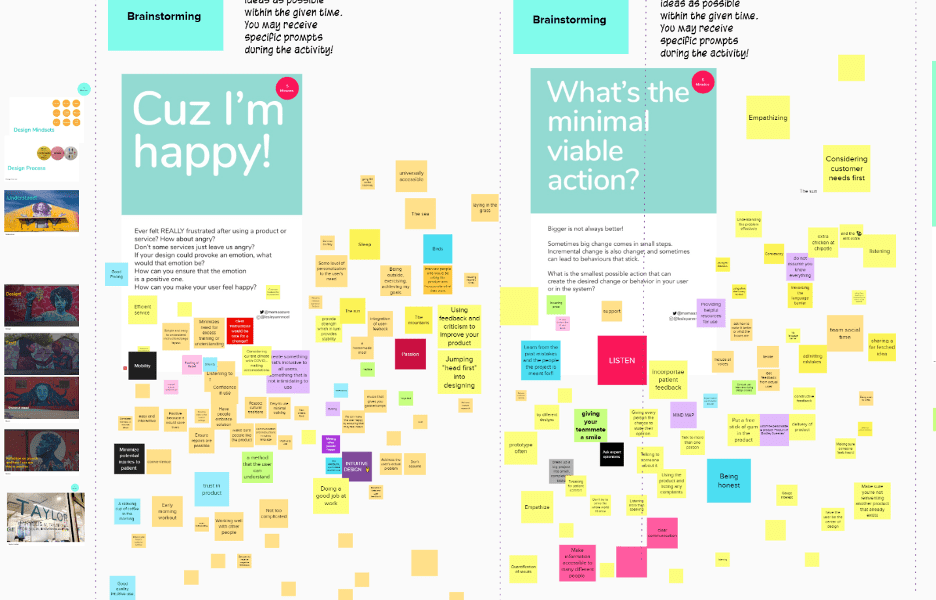
Design Thinking in Biomedical Engineering
“What kind of research needs to be done before brainstorming? How to incorporate many voices? How to get unstuck in brainstorming/design thinking?”
“How to combine ideas with teammates and talk through differences–if one opinion doesn’t think an idea is feasible, how do you convince them otherwise?”
– thoughts from two Tulane University undergraduate biomedical engineering students during a design thinking workshop led by the Taylor Center
Dr. Katherine Raymond, Professor of Practice at the Tulane School of Science and Engineering, was eager to bring design thinking back into the realm of thought for her class of 36 biomedical engineering seniors. “Last year, we held an ideation session with Dr. Lesley-Ann Noel and her colleagues,” she explained. “It was a refreshing and fun experience. It expanded my students’ thought processes about the problems they are trying to solve as their capstone projects.”
Building on her past interdisciplinary design thinking work in Latin and Mathematics courses, Dr. Lesley-Ann Noel supported the Design Thinking Graduate Assistants Shaymaa Abdalal and Niesha Ford in planning this session for a very new audience. Abdalal and Ford were excited to see how allied fields of science utilize a design thinking approach. Trying innovative ways to make classes engaging is always a challenge and finding creative solutions and applying in student projects was the main idea of this workshop.
Workshop Preparation
In a previous class, the students had already completed a prototyping session. They had just reviewed brainstorming techniques and were required to submit an assignment summarizing their brainstorming activity for the following week.
In this workshop, the students would be working on brainstorming solutions to their needs statements, reviewing the design process, and expanding their understandings on design thinking as an important component of their work. Other objectives were to introduce students to some new tools/techniques and spend time with their groups to use those strategies that the workshop leaders would help them appreciate.
Workshop Activities
First, Abdalal and Ford wanted to get students accustomed to using Mural, a virtual collaborative workspace for teams. They asked the students to move pins on a world map to “Where they would want to be right now” and write their name on digital sticky notes.
Abdalal then explained Design Mindsets which was an explanation of what a design mind is in simple terms— being “curious” and “creative”. Ford explained a design thinking model: “Understand” “Design” and “Test”, emphasizing that this workshop would focus on the brainstorming part of this model.
After that they did three prompts, students were given five minutes each to add as many sticky notes as possible with their creative ideas for the given prompt. It was emphasized that the sticky notes didn’t need to be full sentences or well-thought-out, but just what they were thinking. Mozart music was played in the background to motivate students as they added sticky notes.
At the end of the workshop, facilitators read out some of the sticky notes under each prompt and asked the students to share their thoughts that came up while writing the notes.
Student Reflections
(We asked students to tell us what they liked, what they wish, and what they wonder)
I liked…..(tell us what you liked about the workshop)
- Getting in the mindset of design thinking and brainstorming. Thinking about important aspects such as empathy and cost of design.
- The braining storming tool with a time limit is helpful; emphasis on quantity or quality is important.
- How interactive it was and so easy for lots of people to put their ideas in one place. Also I liked the prompts.
- Highly interactive and welcoming environment.
- The platform that was used was very interactive.
I wished…..(tell us something you wish you saw or learned in the workshop)
- Are there more tools to use than just the stick notes?
- I wished we got to share out more of the responses.
- More time to discuss what our notes and talk but really well done though.
- There was less time for each segment.
I wonder….. (tell us something you would want to learn more about in design thinking -a workshop you would want to see, topics we could explore, etc)
- I was wondering if you could somehow tell if there were multiples of the same answer or similar answers and then they could be grouped together.
- Use statistics to paint the picture. Example: 53% of designers say they used sticky notes to create their breakthrough product. Well executed class though 🙂
Facilitator’s experience
From Shaymaa Abdalal: “As one of our workshop objectives we were able to help them with tools needed, I was very happy to hear about their interest in Mural and other visual collaborative teamwork resources that we shared with them. In the future, I wish to incorporate more breakout room time and allow people more time to talk about their projects.”
From Niesha Ford: “This was my first workshop so I was really worried about working with Mural, not knowing enough about design theory to explain it to students, and just generally afraid the students would not like it. I felt good about the workshop overall but was worried about too much time given for the prompts and not enough time for reflection and feedback however it was hard to know if less time would have been better.”
Note to the presenters from Dr. Raymond, “Thank you Niesha and Shaymaa for a wonderful workshop today! I loved the active learning, new tool, and encouragement of creative thinking. All of the students were engaged and had a voice through their ability to contribute on Mural. And I learned some new things too. Thank you again!”
Written by: Shaymaa Abdalal, Sneha Rout, and Niesha Ford.